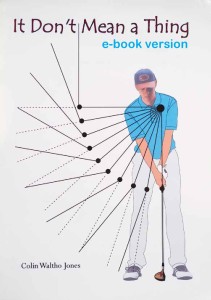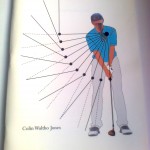This is a “lesson” on chipping and putting.
10th January 2012
Chipping and putting
This practice routine starts with the same exercise but then ends in either of two ways.
The core exercise is designed to get you to look for a pendulumic rhythm that is so perfect that you can feel the ball “sitting” on the blade. I have experienced this phenomenon in all the sports I have played since I discovered the secret of “timing”. It occurs as a sort of “stickiness”; that is, the object being propelled feels, just at the point of impact, as if it is stuck to the club (or racket, or hand etc). A “sticky” shot feels more like a “fling” than a “hit”. “Sticky” shots are always perfect.
Golf is the most difficult game to experience “stickiness”: partly because the club head is made of an inelastic substance and so the collision is relatively inelastic, and partly because the two pendulums that make up the whole motion are so big that they are difficult to synchronise perfectly.
The physics suggests that “stickiness” occurs when the collision is such that the ball takes the maximum length of time to squash up against the club and then release off it. “Stickiness”, therefore, represents control because the longer the ball stays on the club the more chance there is that it will end up exactly where you wanted it to end up. To bring this idea visually alive: imagine the difference in terms of control between hitting a soft tennis ball with a softly strung racket, and hitting a ball-bearing with a frying pan.
The core exercise, then, is chipping to a target about 8 to 10 feet away. You will need a good few balls because it will take a few balls to find any sort of rhythm. You will also need a target. Treat every shot as if it was a proper golf shot in its own right. To help you keep the visualisation fresh, choose a practice area where you can change the location of the ball without having to alter the length of the shot.
When you are imagining the rhythm, I want you to concentrate on that feeling at the top of the backswing that I have mentioned before. It is the feeling that the minute amount of kinetic energy you have put into your pendulumic system to start the swing off has converted completely into potential energy and the swing has come to a comfortable position at the top of the backswing. Once there it has a momentary rest, and in that moment of rest, fleeting as it is, you have the very definite feeling that the swing is desperate to get back to the ball. Also in that moment of rest, the moment you notice that the swing wants to make its way back to the ball you make a very definite decision to allow it to go back to the ball, and a very definite decision not to interfere.
Free of the pressures of actually playing, as long as you concentrate on getting this feeling, you should be able to manage it within a couple of shots. Once you are getting it, you can extend the imagining bit to include a sense of taking a long time to get through the “hitting area”. You can imagine this easily enough because you will have a strong sense of how long you normally take to get through the ‘hitting area’. There is absolutely NO sense of swinging slowly in all of this, just that getting through the hitting area is going to take a little longer than usual with the express aim of getting the feeling that the ball is “sitting” on the blade.
I think the very short chip is the perfect shot for this exercise because the swing is just big enough to be a definite double-pendulum swing, but short enough to offer a chance of perfect synchronisation.
Also, I think someone with your natural ability will get the ball to “sit” on the blade relatively quickly. Once you do, you can either move away from the target and see if you can maintain that rhythm for longer shots; or you can move on to the green and see if you can putt with the rhythm. If you move on to the green then start with putts no more than 2.5’ feet from the hole because it is always worth maximising the positive aural and visual psychological effect of holing out. If you move to longer shots then make sure you stay close enough to the target that you can sense exactly how hard you need to hit the ball.
Best of luck.
Colin


